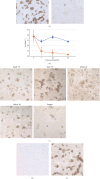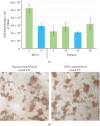Propagation and Sequencing of African Swine Fever Virus on Porcine-Derived Buffy Coat Fraction Cells
- PMID: 40771841
- PMCID: PMC12328057
- DOI: 10.1155/tbed/1160908
Propagation and Sequencing of African Swine Fever Virus on Porcine-Derived Buffy Coat Fraction Cells
Abstract
African swine fever (ASF) has emerged as a preeminent threat to worldwide pork production. Research and diagnostics of ASF virus (ASFV) is dependent upon culturing virus in primary cells, such as peripheral blood macrophages (PBMC) derived from swine blood, or pulmonary alveolar macrophages (PAM) extracted from swine lungs. The methodologies for production of these cells can be laborious, requiring significant investment in vivarium, personnel, and technical resources. As an alternative, the buffy coat cell fraction from blood contains a mixture of cell types, including undifferentiated monocytes that can be easily isolated by centrifugation. Herein, we culture buffy coat cells in macrophage (M∅) base media, containing L929 conditioned media to induce monocyte differentiation and enhance sensitivity to ASFV. Culturing the buffy coat cell fraction in M∅ base media enhanced the abundance of rosettes and number of detectable ASFV genome copies relative to buffy coat cells grown without L929 conditioned media. Buffy coat fraction cells were used to propagate ASFV directly from blood of infected swine and subsequent sequencing of extracted viral DNA yielded full genome coverage and identification of point mutations. This work demonstrated that growing ASFV in cells of the buffy coat fraction for pig blood was an effective alternative to using the traditionally isolated primary cell types for ASFV propagation, isolation, and sequencing.
Keywords: African swine fever virus; buffy coat; hemadsorption; primary cells; sequencing; swine; virus isolation.
Copyright © 2025 Jessica Mason et al. Transboundary and Emerging Diseases published by John Wiley & Sons Ltd.
Conflict of interest statement
The authors declare no conflicts of interest.
Figures


Similar articles
-
Targeted Whole Genome Sequencing of African Swine Fever Virus and Classical Swine Fever Virus on the MinION Portable Sequencing Platform.Pathogens. 2025 Aug 13;14(8):804. doi: 10.3390/pathogens14080804. Pathogens. 2025. PMID: 40872314 Free PMC article.
-
African swine fever virus infection enhances CD14-dependent phagocytosis of porcine alveolar macrophages to promote bacterial uptake and apoptotic body-mediated viral transmission.J Virol. 2025 Jul 22;99(7):e0069025. doi: 10.1128/jvi.00690-25. Epub 2025 Jun 12. J Virol. 2025. PMID: 40503879 Free PMC article.
-
From hemorrhage to apoptosis: understanding the devastating impact of ASFV on piglets.Microbiol Spectr. 2025 Aug 5;13(8):e0290224. doi: 10.1128/spectrum.02902-24. Epub 2025 Jul 11. Microbiol Spectr. 2025. PMID: 40642987 Free PMC article.
-
African Swine Fever Virus Circulation between Tanzania and Neighboring Countries: A Systematic Review and Meta-Analysis.Viruses. 2021 Feb 15;13(2):306. doi: 10.3390/v13020306. Viruses. 2021. PMID: 33672090 Free PMC article.
-
Risk factors for the spread of African Swine Fever in China: A systematic review of Chinese-language literature.Transbound Emerg Dis. 2022 Sep;69(5):e1289-e1298. doi: 10.1111/tbed.14573. Epub 2022 May 11. Transbound Emerg Dis. 2022. PMID: 35490407 Free PMC article.
References
-
- R. Eustace Montgomery. On A Form of Swine Fever Occurring in British East Africa (Kenya Colony) Journal of Comparative Pathology and Therapeutics . 1921;34:159–191. doi: 10.1016/S0368-1742(21)80031-4. - DOI
MeSH terms
LinkOut - more resources
Full Text Sources
Research Materials
Miscellaneous

